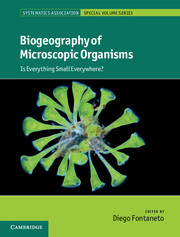Book contents
- Frontmatter
- Contents
- List of contributors
- Preface
- Part I Theoretical framework
- Part II Prokaryotes
- Part III Unicellular eukaryotes
- Part IV Pluricellular eukaryotes
- 9 Coalescent analyses reveal contrasting patterns of intercontinental gene flow in arctic-alpine and boreal-temperate fungi
- 10 Biogeography and phylogeography of lichen fungi and their photobionts
- 11 Biogeography of mosses and allies: does size matter?
- 12 Dispersal limitation or habitat quality – what shapes the distribution ranges of ferns?
- 13 Ubiquity of microscopic animals? Evidence from the morphological approach in species identification
- 14 Molecular approach to micrometazoans. Are they here, there and everywhere?
- Part V Processes
- Index
- Systematics Association Publications
- Systematics Association Special Volumes
- Plate section
- References
10 - Biogeography and phylogeography of lichen fungi and their photobionts
from Part IV - Pluricellular eukaryotes
Published online by Cambridge University Press: 05 August 2012
- Frontmatter
- Contents
- List of contributors
- Preface
- Part I Theoretical framework
- Part II Prokaryotes
- Part III Unicellular eukaryotes
- Part IV Pluricellular eukaryotes
- 9 Coalescent analyses reveal contrasting patterns of intercontinental gene flow in arctic-alpine and boreal-temperate fungi
- 10 Biogeography and phylogeography of lichen fungi and their photobionts
- 11 Biogeography of mosses and allies: does size matter?
- 12 Dispersal limitation or habitat quality – what shapes the distribution ranges of ferns?
- 13 Ubiquity of microscopic animals? Evidence from the morphological approach in species identification
- 14 Molecular approach to micrometazoans. Are they here, there and everywhere?
- Part V Processes
- Index
- Systematics Association Publications
- Systematics Association Special Volumes
- Plate section
- References
Summary
Introduction
Lichens are the classical example of mutualistic symbiosis (de Bary, 1879). The first researcher to recognise the dual nature of lichens was the Swiss botanist and lichenologist Simon Schwendener (1868), whose theory on the algal–fungal association of lichens was rejected by the leading lichenologists at the time, to become widely accepted only in the twentieth century when lichens had been resynthesised from aposymbiotic cultures for the first time (for review, see Honegger, 2000). The lichen symbiosis is shaped by a fungus (‘mycobiont’) which forms an intimate association with a photosynthetic partner (‘photobiont’). In the lichen symbiosis, a single fungal species associates either with one or several species of green algae or cyanobacteria, or sometimes with both taxa (‘tripartite’ lichen).
More than 15 000 species of lichen fungi are known to date, belonging to about 1000 genera (Kirk et al., 2008); 98% of these species are ascomycetes (Honegger, 2008), the remaining are basidiomycetes or fungi of unclear systematic position (Tehler and Wedin, 2008; Printzen, 2010). In contrast, only about 100 photobiont species (Lücking et al., 2009) belonging to about 40 genera have been reported (Ahmadjian, 1967; Tschermak-Woess, 1988; Büdel, 1992; Nyati et al., 2007). This vast discrepancy in numbers implies that a large number of lichen fungi share a common pool of photobionts. The photobionts of lichens include eukaryotic green algae (phylum Chlorophyta), other eukaryotic algae (phylum Heterokontophyta), as well as cyanobacteria.
- Type
- Chapter
- Information
- Biogeography of Microscopic OrganismsIs Everything Small Everywhere?, pp. 191 - 208Publisher: Cambridge University PressPrint publication year: 2011
References
- 25
- Cited by



